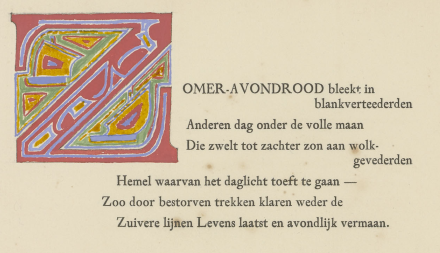The P.C. Boutens Collection > About the collection
Literary legacy
P.C. Boutens’ literary legacy was acquired from his heirs in 1996; it numbers some four hundred books, including valuable first (and often limited) editions. Many of these books are printed on high-quality paper with a vellum or leather binding, and some bear a signed dedication in the author’s own handwriting. A few books contain rectifications in the poet’s own handwriting. In addition, the collection includes editions that were never brought to market: some of them had been intended for the author’s private use only.
Special copies
Boutens always stipulated that the publisher give him a number of complimentary copies. The catalogue of the Boutens Collection mentions for instance that “45 copies of his Oud-Perzische kwatrijnen (Old Persian quatrains) were printed on Japanese imperial paper bound in red morocco leather with lovely marbled pastedowns and flyleaves”. Such copies were generally meant for his friends and patrons, the latter usually receiving a steep bill along with their copy.
Prominent publishers and master typographers
Boutens’ beautifully designed books also reflect the role he played at a time when Dutch book publishing was undergoing a revival around 1900. He had his work printed by reputable publishers such as C.A.J. van Dishoeck and A.A.M. Stols, with designs from master typographers such as Jan van Krimpen, Sjoerd H. de Roos and Jean François van Royen.
Boutens also liked to collaborate with specialized publishers, e.g. Verbeeke’s Sint-Catherine Drukkerij in Bruges and artists such as Jan Toorop. His interest in book design went hand in hand with his philosophy: beautiful poems which would remain valued for ages deserved to be printed in a costly and durable book.
The catalogue
The 1997 catalogue De P.C. Boutens-collectie van de Zeeuwse Bibliotheek (The P.C. Boutens Collection of the Zeeland Library) contains a full inventory of the collection. The material for the Metamorfoze Project was put on microfiche in 1998 and was digitized in 2008. Everything is on view in the Memory of the Netherlands: letters and manuscripts, first editions and complimentary copies, examples of artful binding and outstanding designs, as well as books dedicated to Boutens by other authors.

